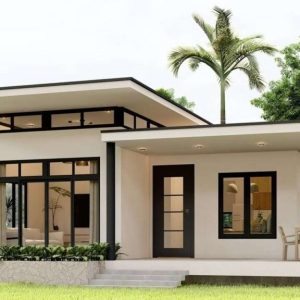Architects : DP6 architectuurstudio
Area : 120 m²
Photographs : Michel Kievits

In the rural landscape between the villages of Makkinga and Donkerbroek in the northern province of Friesland (The Netherlands), the Makkinga house lies secluded by trees. Its orientation and use of materials create the effect of a dialogue with the surrounding natural landscape.

Now demolished, the old house that originally stood on this site appeared to be oblivious to its exquisite context, offering just a single small window through which to view the magnificent landscape, an almost hidden entrance on the north side, and rooms that were cramped, cold and draughty.

The new house is its complete opposite, making full use of the natural qualities offered by its surroundings.

To the east, the site faces a road connecting two villages. On this side the entrance to the house gives out on the access road, while the facade, like the one on the north side, has been kept largely closed to ensure a degree of privacy.

On the west side, which is the ‘living side’ of the house, a dialogue has been created with the wide vista offered by the Friesian farmland, and the volume opens up to its full extent. The long veranda on the west side emphasises the openness of the landscape, whereas the south side with its compact terrace brings you in close contact with the introvert nature of the woodland.

In a consistent process of collaboration with the client, the design was moulded into a snug overcoat. The enclosed east side offers room for concentrated study, with a view of the entrance to notice guests when they arrive.

The sleeping quarters with integrated wall storage units are located on the northwest side.

The living and dining areas establish a link between the exterior and the interior, turning the landscape into an integrated part of the experience created by the room. Living in the house, inside becomes outside, and the wildlife almost appears to be inside.

DP6 has created a minimalist house presenting an exterior of glass and wood. The timber cladding merges with the surroundings, and the combination of black and natural larch wood wraps the volume with intricate detail.

The house is designed and detailed like a piece of furniture, with walls, floors and ceilings that continue outside.

The brief called for sunlight, sustainability, comfort and a dialogue with the landscape. The orientation of the house has been optimised to make full use of the sun’s energy.

A wide overhang protects the terrace on the west side from the sun in high summer, while in the spring and the autumn, when the sun is not as high in the sky, the welcome warmth of its rays is captured to full effect. The short south side is fully glazed, too.

In addition to the overhang, the trees also help to filter the daylight. On the north and east sides, the house presents a closed exterior, reducing heat losses to a minimum.

The optimised orientation combines with the triple glazing, a highly insulated building shell and draught-proof details to create a highly energy-efficient and comfortable house.





